2022 HYUNDAI IONIQ ELECTRIC brake
[x] Cancel search: brakePage 505 of 546
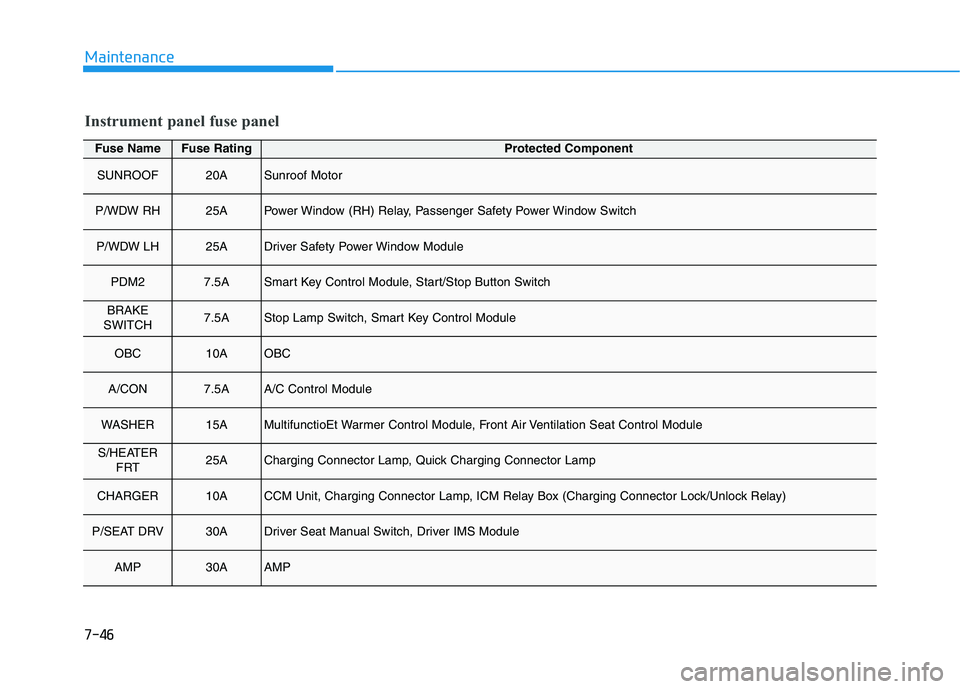
7-46
Maintenance
Fuse NameFuse RatingProtected Component
SUNROOF20ASunroof Motor
P/WDW RH25APower Window (RH) Relay, Passenger Safety Power Window Switch
P/WDW LH25ADriver Safety Power Window Module
PDM27.5ASmart Key Control Module, Start/Stop Button Switch
BRAKE
SWITCH7.5AStop Lamp Switch, Smart Key Control Module
OBC10AOBC
A/CON7.5AA/C Control Module
WASHER15AMultifunctioEt Warmer Control Module, Front Air Ventilation Seat Control Module
S/HEATER FRT25ACharging Connector Lamp, Quick Charging Connector Lamp
CHARGER10ACCM Unit, Charging Connector Lamp, ICM Relay Box (Charging Connector Lock/Unlock Relay)
P/SEAT DRV30ADriver Seat Manual Switch, Driver IMS Module
AMP30AAMP
Instrument panel fuse panel
Page 509 of 546
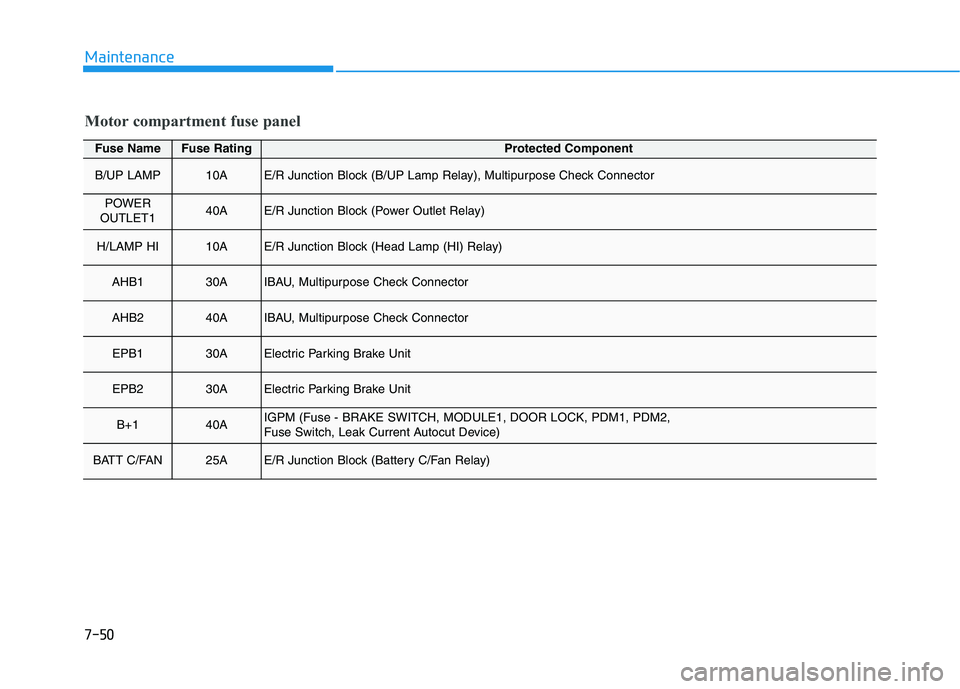
7-50
Maintenance
Motor compartment fuse panel
Fuse NameFuse RatingProtected Component
B/UP LAMP10AE/R Junction Block (B/UP Lamp Relay), Multipurpose Check Connector
POWER
OUTLET140AE/R Junction Block (Power Outlet Relay)
H/LAMP HI10AE/R Junction Block (Head Lamp (HI) Relay)
AHB130AIBAU, Multipurpose Check Connector
AHB240AIBAU, Multipurpose Check Connector
EPB130AElectric Parking Brake Unit
EPB230AElectric Parking Brake Unit
B+140AIGPM (Fuse - BRAKE SWITCH, MODULE1, DOOR LOCK, PDM1, PDM2,
Fuse Switch, Leak Current Autocut Device)
BATT C/FAN25AE/R Junction Block (Battery C/Fan Relay)
Page 511 of 546
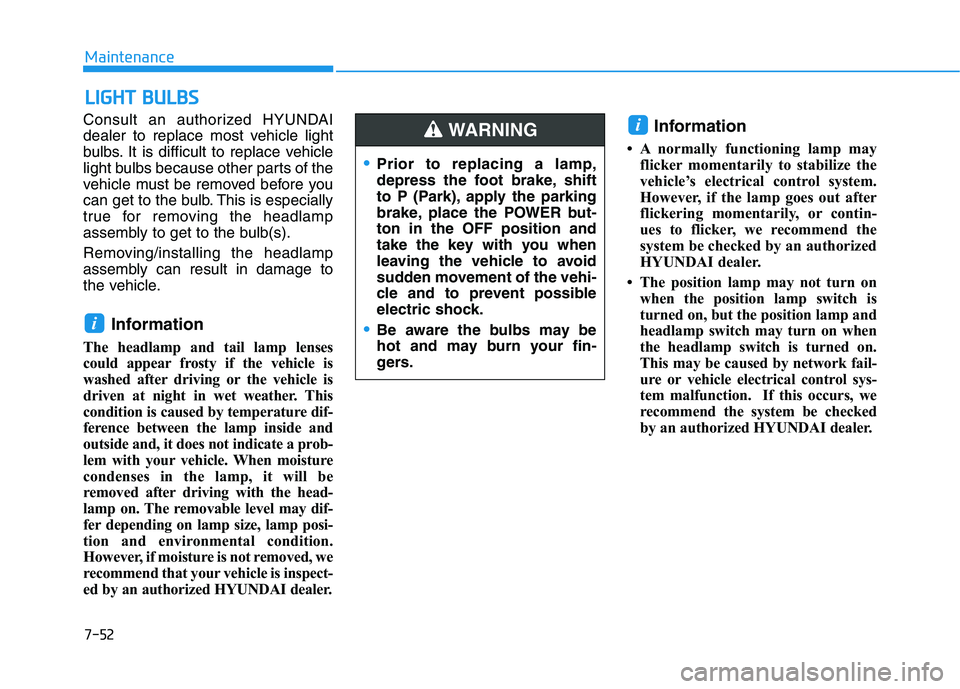
7-52
MaintenanceL
L IIGG HH TT BB UU LLBB SS
Consult an authorized HYUNDAI
dealer to replace most vehicle light
bulbs. It is difficult to replace vehicle
light bulbs because other parts of the
vehicle must be removed before you
can get to the bulb. This is especially
true for removing the headlamp
assembly to get to the bulb(s).
Removing/installing the headlamp
assembly can result in damage to
the vehicle.
Information
The headlamp and tail lamp lenses
could appear frosty if the vehicle is
washed after driving or the vehicle is
driven at night in wet weather. This
condition is caused by temperature dif-
ference between the lamp inside and
outside and, it does not indicate a prob-
lem with your vehicle. When moisture
condenses in the lamp, it will be
removed after driving with the head-
lamp on. The removable level may dif-
fer depending on lamp size, lamp posi-
tion and environmental condition.
However, if moisture is not removed, we
recommend that your vehicle is inspect-
ed by an authorized HYUNDAI dealer. Information
A normally functioning lamp may flicker momentarily to stabilize the
vehicle’s electrical control system.
However, if the lamp goes out after
flickering momentarily, or contin-
ues to flicker, we recommend the
system be checked by an authorized
HYUNDAI dealer.
The position lamp may not turn on when the position lamp switch is
turned on, but the position lamp and
headlamp switch may turn on when
the headlamp switch is turned on.
This may be caused by network fail-
ure or vehicle electrical control sys-
tem malfunction. If this occurs, we
recommend the system be checked
by an authorized HYUNDAI dealer.i
i
Prior to replacing a lamp,
depress the foot brake, shift
to P (Park), apply the parking
brake, place the POWER but-ton in the OFF position and
take the key with you when
leaving the vehicle to avoid
sudden movement of the vehi-
cle and to prevent possible
electric shock.
Be aware the bulbs may be
hot and may burn your fin-
gers.
WARNING
Page 522 of 546
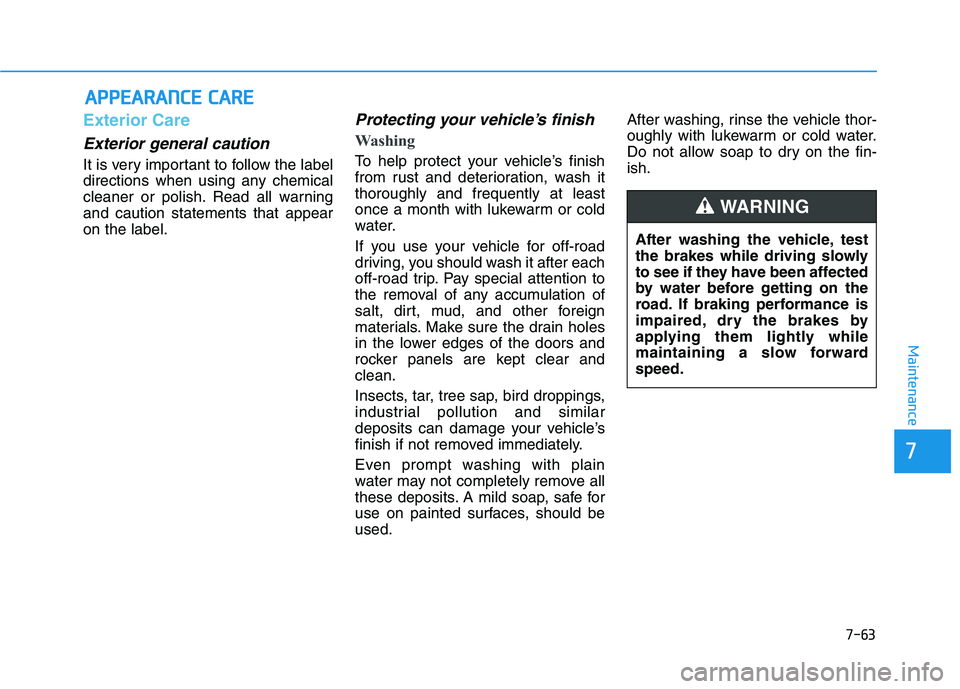
7-63
7
Maintenance
AAPPPPEEAA RRAA NN CCEE CC AA RREE
Exterior Care
Exterior general caution
It is very important to follow the label
directions when using any chemical
cleaner or polish. Read all warningand caution statements that appearon the label.
Protecting your vehicle’s finish
Washing
To help protect your vehicle’s finish
from rust and deterioration, wash itthoroughly and frequently at least
once a month with lukewarm or cold
water.
If you use your vehicle for off-road
driving, you should wash it after each
off-road trip. Pay special attention to
the removal of any accumulation of
salt, dirt, mud, and other foreign
materials. Make sure the drain holes
in the lower edges of the doors and
rocker panels are kept clear andclean.
Insects, tar, tree sap, bird droppings,
industrial pollution and similar
deposits can damage your vehicle’s
finish if not removed immediately.
Even prompt washing with plain
water may not completely remove all
these deposits. A mild soap, safe for
use on painted surfaces, should beused. After washing, rinse the vehicle thor-
oughly with lukewarm or cold water.
Do not allow soap to dry on the fin-ish.
After washing the vehicle, test
the brakes while driving slowly
to see if they have been affected
by water before getting on the
road. If braking performance is
impaired, dry the brakes by
applying them lightly while
maintaining a slow forwardspeed.
WARNING
Page 525 of 546
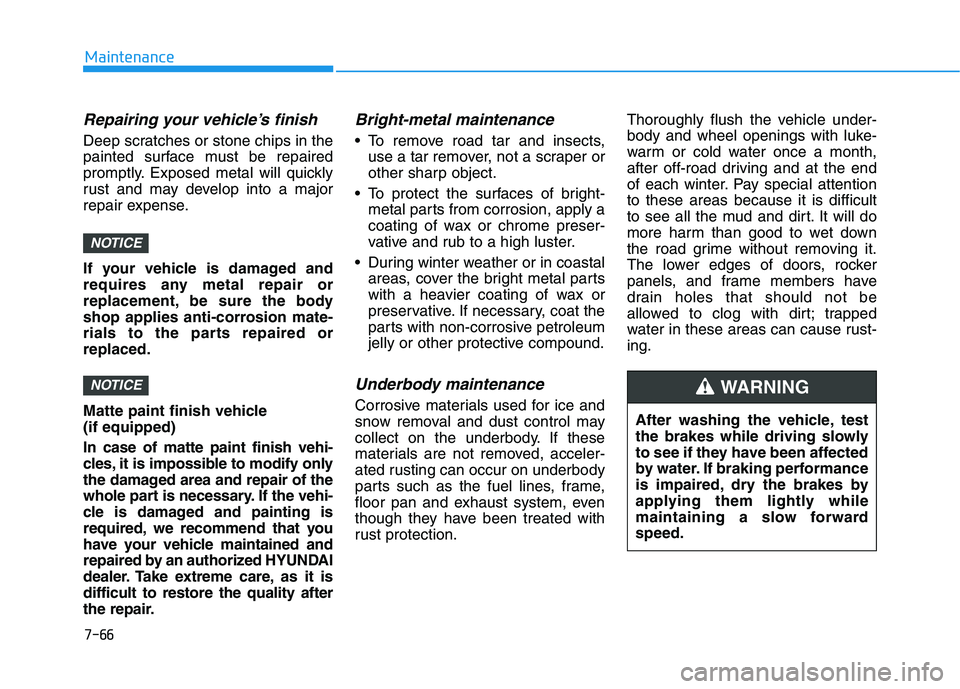
7-66
Maintenance
Repairing your vehicle’s finish
Deep scratches or stone chips in the
painted surface must be repaired
promptly. Exposed metal will quickly
rust and may develop into a major
repair expense.
If your vehicle is damaged and
requires any metal repair or
replacement, be sure the body
shop applies anti-corrosion mate-
rials to the parts repaired orreplaced.
Matte paint finish vehicle (if equipped) In case of matte paint finish vehi-
cles, it is impossible to modify only
the damaged area and repair of the
whole part is necessary. If the vehi-
cle is damaged and painting is
required, we recommend that you
have your vehicle maintained and
repaired by an authorized HYUNDAI
dealer. Take extreme care, as it isdifficult to restore the quality after
the repair.
Bright-metal maintenance
To remove road tar and insects,use a tar remover, not a scraper or
other sharp object.
To protect the surfaces of bright- metal parts from corrosion, apply a
coating of wax or chrome preser-
vative and rub to a high luster.
During winter weather or in coastal areas, cover the bright metal parts
with a heavier coating of wax or
preservative. If necessary, coat the
parts with non-corrosive petroleum
jelly or other protective compound.
Underbody maintenance
Corrosive materials used for ice and
snow removal and dust control may
collect on the underbody. If these
materials are not removed, acceler-
ated rusting can occur on underbody
parts such as the fuel lines, frame,
floor pan and exhaust system, even
though they have been treated with
rust protection. Thoroughly flush the vehicle under-
body and wheel openings with luke-
warm or cold water once a month,
after off-road driving and at the end
of each winter. Pay special attentionto these areas because it is difficult
to see all the mud and dirt. It will do
more harm than good to wet down
the road grime without removing it.
The lower edges of doors, rocker
panels, and frame members have
drain holes that should not be
allowed to clog with dirt; trapped
water in these areas can cause rust-ing.
NOTICE
NOTICE
After washing the vehicle, test
the brakes while driving slowly
to see if they have been affected
by water. If braking performance
is impaired, dry the brakes by
applying them lightly while
maintaining a slow forwardspeed.
WARNING
Page 536 of 546
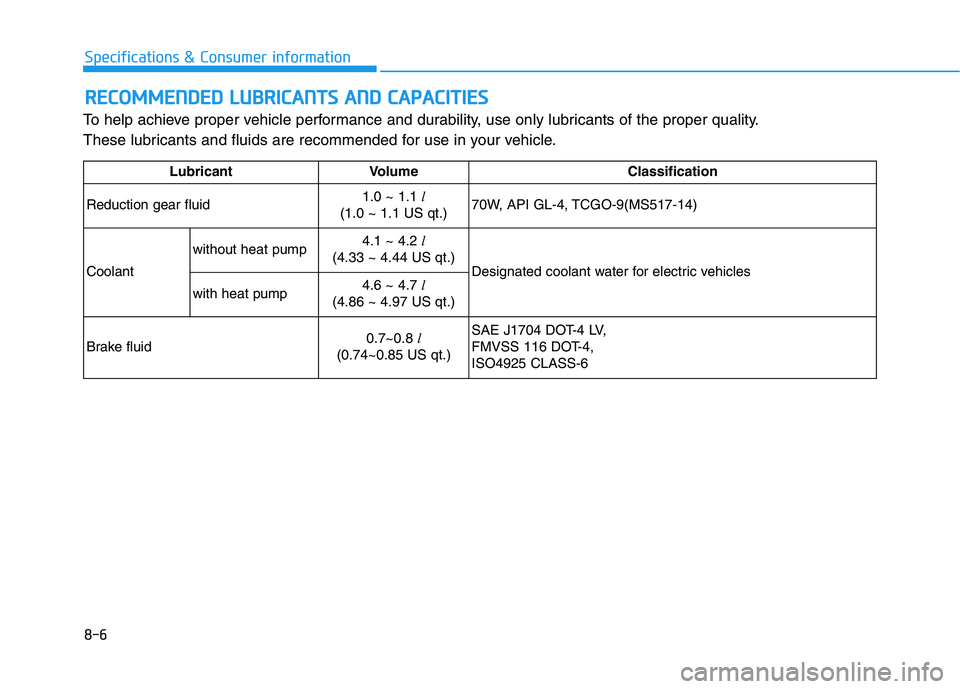
8-6
Specifications & Consumer informationR
R EECCOO MM MMEENN DDEEDD LL UU BBRRIICC AA NN TTSS AA NN DD CC AA PPAA CCIITT IIEE SS
To help achieve proper vehicle performance and durability, use only lubricants of the proper quality.
These lubricants and fluids are recommended for use in your vehicle.
Lubricant Volume Classification
Reduction gear fluid 1.0 ~ 1.1
l
(1.0 ~ 1.1 US qt.) 70W, API GL-4, TCGO-9(MS517-14)
Coolant without heat pump
4.1 ~ 4.2
l
(4.33 ~ 4.44 US qt.) Designated coolant water for electric vehicles
with heat pump 4.6 ~ 4.7
l
(4.86 ~ 4.97 US qt.)
Brake fluid 0.7~0.8
l
(0.74~0.85 US qt.) SAE J1704 DOT-4 LV,
FMVSS 116 DOT-4,ISO4925 CLASS-6
Page 540 of 546
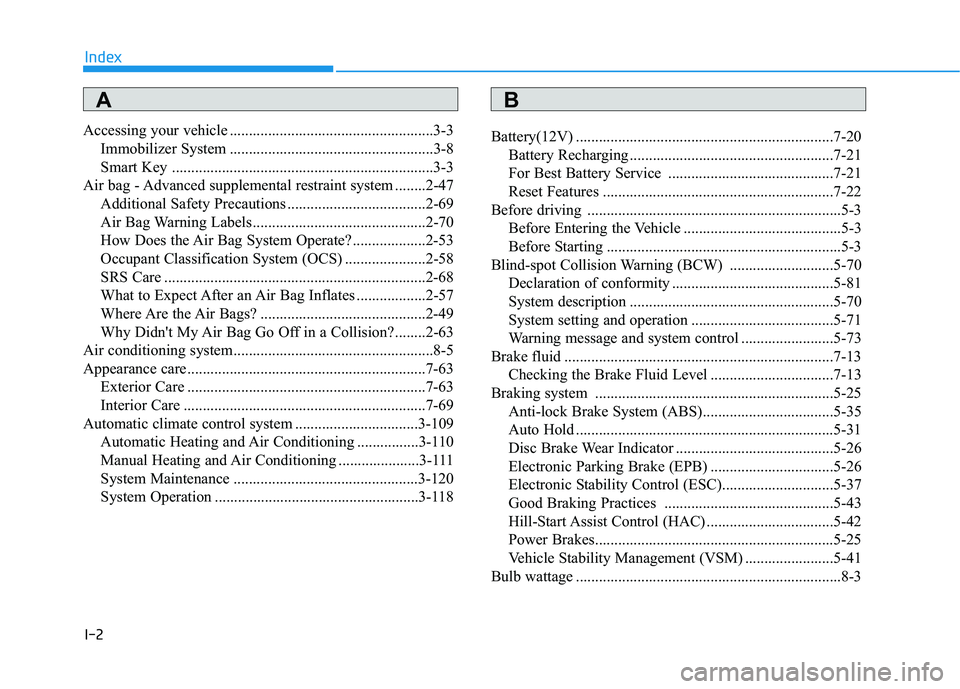
I-2
Accessing your vehicle .....................................................3-3
Immobilizer System .....................................................3-8
Smart Key ....................................................................3-3
Air bag - Advanced supplemental restraint system ........2-47 Additional Safety Precautions ....................................2-69
Air Bag Warning Labels.............................................2-70
How Does the Air Bag System Operate? ...................2-53
Occupant Classification System (OCS) .....................2-58
SRS Care ....................................................................2-68
What to Expect After an Air Bag Inflates ..................2-57
Where Are the Air Bags? ...........................................2-49
Why Didn't My Air Bag Go Off in a Collision?........2-63
Air conditioning system....................................................8-5
Appearance care..............................................................7-63 Exterior Care ..............................................................7-63
Interior Care ...............................................................7-69
Automatic climate control system ................................3-109
Automatic Heating and Air Conditioning ................3-110
Manual Heating and Air Conditioning .....................3-111
System Maintenance ................................................3-120
System Operation .....................................................3-118 Battery(12V) ...................................................................7-20
Battery Recharging .....................................................7-21
For Best Battery Service ...........................................7-21
Reset Features ............................................................7-22
Before driving ..................................................................5-3 Before Entering the Vehicle .........................................5-3
Before Starting .............................................................5-3
Blind-spot Collision Warning (BCW) ...........................5-70
Declaration of conformity ..........................................5-81
System description .....................................................5-70
System setting and operation .....................................5-71
Warning message and system control ........................5-73
Brake fluid ......................................................................7-13 Checking the Brake Fluid Level ................................7-13
Braking system ..............................................................5-25 Anti-lock Brake System (ABS)..................................5-35
Auto Hold ...................................................................5-31
Disc Brake Wear Indicator .........................................5-26
Electronic Parking Brake (EPB) ................................5-26
Electronic Stability Control (ESC).............................5-37
Good Braking Practices ............................................5-43
Hill-Start Assist Control (HAC) .................................5-42
Power Brakes..............................................................5-25
Vehicle Stability Management (VSM) .......................5-41
Bulb wattage .....................................................................8-3
Index
AB
Page 541 of 546
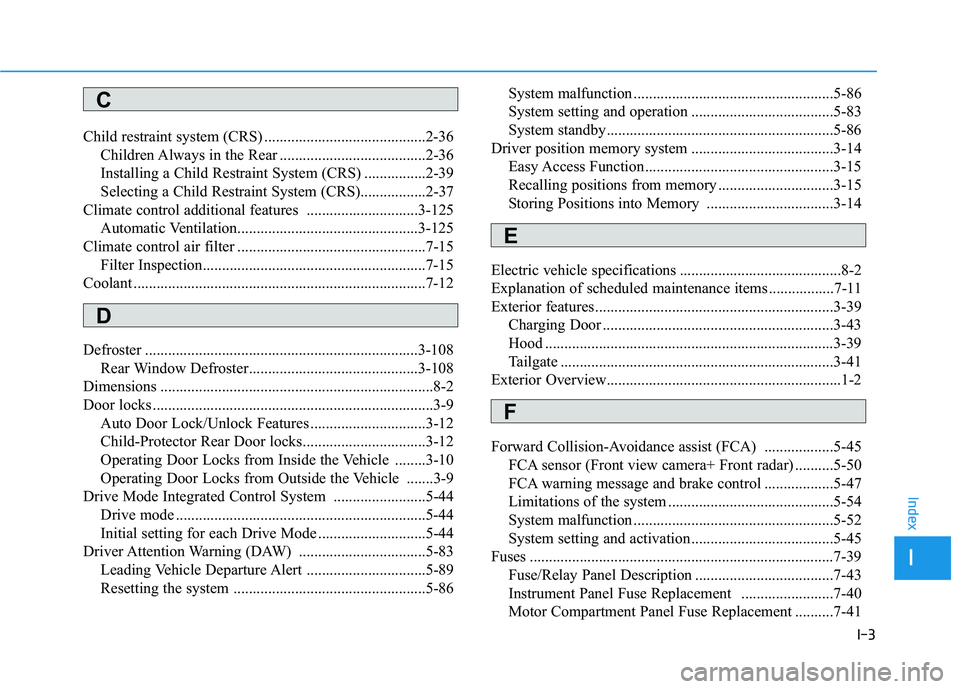
I-3
Child restraint system (CRS) ..........................................2-36
Children Always in the Rear ......................................2-36
Installing a Child Restraint System (CRS) ................2-39
Selecting a Child Restraint System (CRS).................2-37
Climate control additional features .............................3-125 Automatic Ventilation...............................................3-125
Climate control air filter .................................................7-15 Filter Inspection..........................................................7-15
Coolant ............................................................................7-12
Defroster .......................................................................3-108 Rear Window Defroster............................................3-108
Dimensions .......................................................................8-2
Door locks .........................................................................3-9 Auto Door Lock/Unlock Features ..............................3-12
Child-Protector Rear Door locks................................3-12
Operating Door Locks from Inside the Vehicle ........3-10
Operating Door Locks from Outside the Vehicle .......3-9
Drive Mode Integrated Control System ........................5-44
Drive mode .................................................................5-44
Initial setting for each Drive Mode ............................5-44
Driver Attention Warning (DAW) .................................5-83
Leading Vehicle Departure Alert ...............................5-89
Resetting the system ..................................................5-86 System malfunction ....................................................5-86
System setting and operation .....................................5-83
System standby...........................................................5-86
Driver position memory system .....................................3-14
Easy Access Function .................................................3-15
Recalling positions from memory ..............................3-15
Storing Positions into Memory .................................3-14
Electric vehicle specifications ..........................................8-2
Explanation of scheduled maintenance items .................7-11
Exterior features..............................................................3-39 Charging Door ............................................................3-43
Hood ...........................................................................3-39
Tailgate .......................................................................3-41
Exterior Overview.............................................................1-2
Forward Collision-Avoidance assist (FCA) ..................5-45 FCA sensor (Front view camera+ Front radar) ..........5-50
FCA warning message and brake control ..................5-47
Limitations of the system ...........................................5-54
System malfunction ....................................................5-52
System setting and activation .....................................5-45
Fuses ...............................................................................7-39 Fuse/Relay Panel Description ....................................7-43
Instrument Panel Fuse Replacement ........................7-40
Motor Compartment Panel Fuse Replacement ..........7-41
I
Index
C
D
E
F